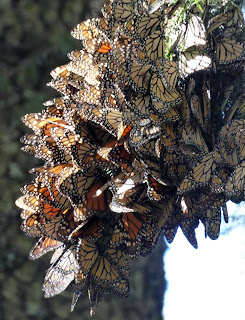The main sight around which my Mexico holiday was designed was the over-wintering grounds of the migratory monarch butterfly. Over the course of a year, they cover a round trip of up to 5,500 miles, taking several generations to do so. The toughest are those that fly from the northern US (or even southern Canada) to Mexico, where they gather in their millions in the pine forests of Michoacán to see out the winter, mostly living on fat reserves although eating and drinking a little on warm days. Then when the temperatures rise sufficiently, some time in March, they set off for Texas. There they mate and lay eggs and die, by that time some eight months old. The generation born there travel further north, mate, lay eggs and die all within the space of a month, as do the next two generations, before the autumn comes and it is time to fly south again. Amazing that this generation knows where to go, when neither their parents nor their grandparents made the journey.
Many areas of the forest where the butterflies over-winter are now protected, and it was nice to see many parties of Mexican school-children there, being shown this spectacular part of their national natural heritage. We visited two different such reserves on two days.
The largest of the two was El Rosario, with perhaps five million butterflies this year. On the day we visited it was quite cold, with the sun mostly obscured by cloud, and so the butterflies were quiet, just perched motionless, with the wings closed. There were none fluttering about. If you passed through that stretch of forest and didn't know the butterflies were there, you might just think that some of the foliage on the trees was dying.
Look more closely however and this is what you see (although easier to spot here as some opened their wings to catch a brief bit of sun):
Millions of butterflies. Covering the tree trunks and hanging from the branches. Apparently sometimes the branches fall from the trees with their weight. They have very few predators at this stage as the milkweed plants they have fed on in the US are poisonous. Only three species of birds in Mexico can digest the poison and we didn't see any of those birds on either of our visits to two different reserves.
On a sunnier day they set off in flight, in search of nearby pools of water to drink, or flowers to feed from, to boost their reserves and help them to make it through the winter. Some die at this stage, having insufficient strength in the cold air to get back to the colony in the trees. We saw many such dead and dying butterflies on the ground.
Overall a really spectacular sight, which I'm glad I finally got round to seeing. A beautiful red warbler seen on the way up (sadly no photo of that) on day one added to the experience too. A warning to anyone tempted to go - the reserves are at some altitude (over 3,000m) so take a horse up (only $5) and walk back down - and dress warmly. I needed my hat and gloves!




No comments:
Post a Comment